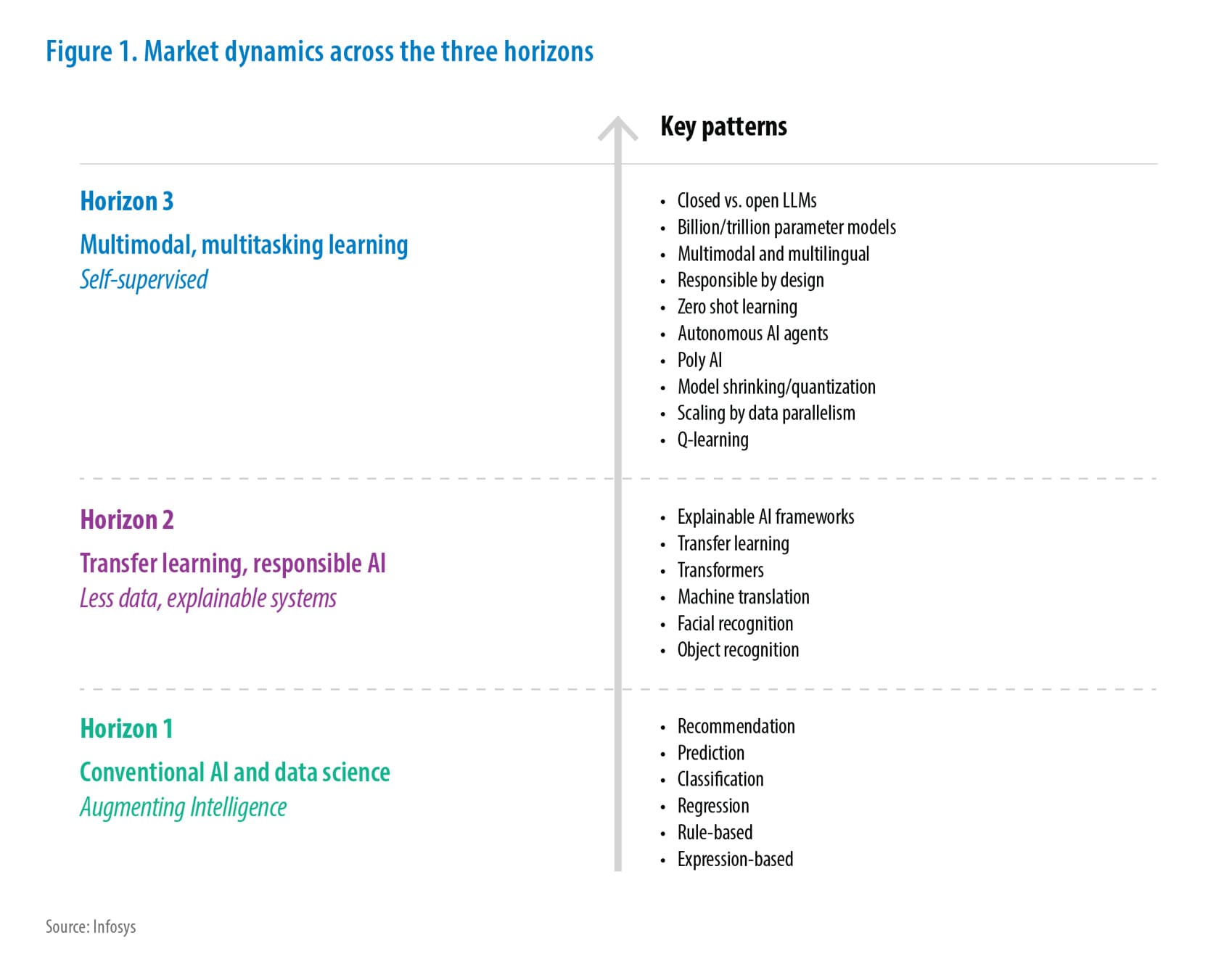5G
Private 5G network deployments
Technology advancements in the last decade have seen rapid pace and penetration in every industry. Next-gen technologies like IoT, blockchain, AI/ML, and the metaverse have exposed a plethora of use cases. A stack of these technologies provides superior performance, minimal disruption, and extreme speed. 5G will make these next-gen use cases a reality. Each use case has its own requirements and needs customization and will not be a one-size-fits-all deployment. One such customization is the development of private 5G networks.
This paper explores deployment scenarios of private 5G networks for enterprises, covering when to use them, pros and cons, challenges, and use cases. We focus specifically on private 5G deployments.
The case for private 5G
Private 5G networks operate like public 5G networks. While a public network is managed by a mobile network operator, a private network is managed by the organization that sets it up. Large enterprises purchase wireless spectrum from mobile operators or governments to set up their private 5G network, which their employees exclusively access. Reliability is one the main reasons behind deploying private 5G over Wi-Fi.
While Wi-Fi and private 5G can coexist and complement each other, here are some of the advantages of private 5G over Wi-Fi:
- Larger coverage: Private 5G covers larger areas with fewer access points (APs) because of a higher power rating than Wi-Fi.
- Better mobility: Provides better mobility, as devices can move between APs without losing data.
- Connected devices A single Wi-Fi channel can connect up to 45 devices, while private 5G can connect up to 1 million devices per square kilometer.
- Assured quality of service (QoS): Guarantees QoS, as network slicing features ensure that each application gets the required bandwidth. Network slicing features in a private 5G increase throughput and speed while ensuring QoS control and granularity for each application.
- Minimal interference: Less susceptible to interference as it uses different frequency bands, while Wi-Fi networks are interfered by other Wi-Fi Networks, Bluetooth devices, electromagnetic waves from microwave, and physical obstacles.
- Different spectrum bands: Uses different spectrum bands (low to ultra-high frequencies), depending on the use case. This gives more flexibility to enterprises in how they deploy their network.
- More secure: Private 5G is more secure than Wi-Fi, as it uses additional security features such as:
- AUSF and security anchor function make spoofing the 5G network difficult.
- Encrypted IMSI makes it difficult to track the subscriber.
- Network slicing overlays multiple virtual networks on top of a shared network and computing resources, which can isolate devices from the network.
Private 5G offers superior service and customer experience and supports huge number of complex use cases that Wi-Fi cannot. These use cases include industrial automation, smart cities, connected vehicles, smart energy/utilities, remote healthcare, etc.
Private 5G deployment architecture
Below is a typical architecture for a standard 5G implementation, with multiple deployment types explored in the subsequent sections.
Figure 1 – Private 5G architecture
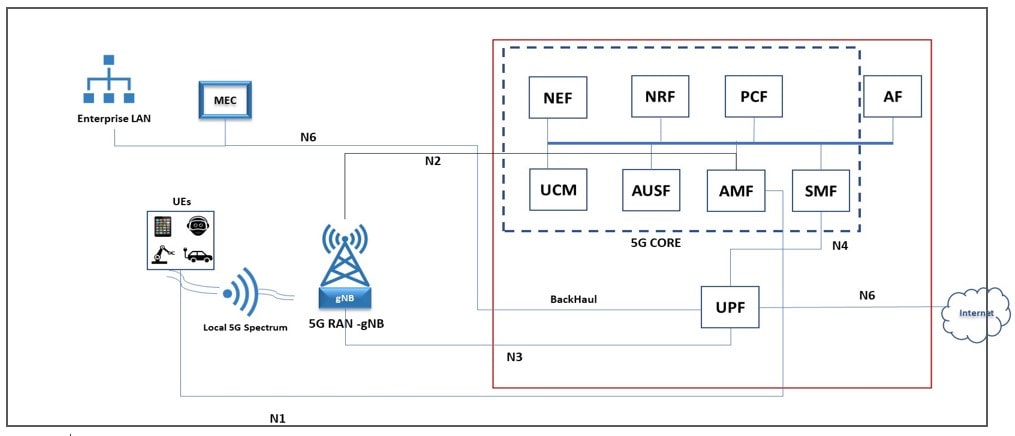
Source: Infosys
The below table explains each component shown in Figure 1:
Table 1: Components of 5G deployment
| Component | Description |
|---|---|
| Multiaccess edge computing (MEC) | Offers cloud computing at the edge of the network for application developers and content providers. It delivers ultra-low latency and high bandwidth at the edge of the network. This combines elements of IT technology stack and cloud computing to deliver a software network framework at the edge of a 5G network |
| gNode Base Station (gNB or gNodeB) | It is a node in a cellular network that provides connectivity between user equipment (UE) and evolved packet core (EPC) |
| User plane function (UPF) | It is responsible for packet inspection, QoS handling, external PDU session, and packet routing, and forwarding for interconnecting data network (DN) |
| Access and mobility management function (AMF) | Supports NAS ciphering and integrity protection, termination of NAS signaling, access authentication and authorization, managing connections and registrations, security context management, and mobility management |
| Session management function (SMF) | Supports allocation of UE IP address, management of sessions and management, DHCP functions, termination of NAS signaling related to DL data notification, traffic steering configuration and session management, for proper traffic routing for UPF |
| Policy control function (PCF) | Provides policy rules to CP functions, unified policy framework, and accessing of subscription information for policy |
| Authentication server function (AUSF) | Acts primarily as an authentication server |
| Unified data management (UDM) | Supports handling of user identification, generation of authentication and key agreement credentials, managing subscriptions and access authorization |
| Application function (AF) | Supports accessing the NEF, influencing of application on traffic routing, and interacting with the policy framework for policy control |
| Network exposure function (NEF) | Supports translation of internal or external information, secure provision of information from external applications to 3GPP network, and exposure of events and capabilities |
| Network repository function (NRF) | Maintains NF profiles, available NF instances, and provides service discovery function |
| Network slice selection function (NSSF) | Determines the AMF set to be used to serve the UE, selects Network Slice instances to serve the UE, and determines the allowed NSSAI |
Source: Infosys
When to deploy a private network – scenarios
Private networks pave the way for enterprises to provide secure solutions with superior user experience, led by a growing need for ultra-high speeds and reliability to support a multitude of use cases across industries. Here are some scenarios where an enterprise might want to consider setting up a private network:
Case 1: Network availability in less populated large areas
5G provides better connectivity in sparsely populated areas than Wi-Fi. Right service with desired user experience is challenging in these areas. For example, industries that plan to set up large manufacturing plants outside city limits will face challenges in implementing industrial automation due to limited network coverage. In such a scenario, an enterprise can leverage the advantages of 5G connectivity. Also, telemedicine in rural areas, drone-based services for the supply of medicines to remote areas, and other last-mile connectivity applications can all benefit from 5G's advanced capabilities.
Case 2: Secure networks
Cybersecurity is crucial for businesses to provide safe and secure services. Private 5G networks offer mobility, low latency, high bandwidth, and privacy by limiting the use of public interfaces to only when needed, such as when dealing with customer intellectual property, sensitive customer data, or sensitive activities. This reduces the potential security threats.
For example, 5G Release 17 has introduced new features for user plane integrity protection, security for industrial IoT, security against false base stations, and security of direct discovery, direct communication, and relay communication. Due to the AUSF and Security Anchor Function in 5G, it is harder to spoof authentication messages to the core network. Also, unlike in 4G networks, IMSI is encrypted in 5G, making it more difficult to track subscribers using the air interface.
Case 3: Mission-critical applications
Some industries need extreme high speeds and low latencies to support mission-critical applications that need real-time support. For example, tactile projections in healthcare enable surgeons to perform remote surgeries in real time. Private 5G networks can establish healthcare systems that support such mission-critical applications.
Case 4: Campus networks
Campus networks on 5G provide exclusive access to people and devices within a defined local area, such as universities, residential or commercial buildings, industrial plants, etc. These networks are tailored to the individual needs of users and can support next-gen use cases that require high bandwidth, low latency, and secure access to meet future requirements of Industry 4.0. This is especially beneficial for research institutions that focus on cutting-edge use cases like drone-based research, immersive experiences like the metaverse, and remote-guided vehicles.
Private 5G offers the following features for campus networks:
- Completely private wireless connectivity
- High reliability
- High bandwidth and throughput
- Mobility
- Data security
- Ultra-low latency
Case 5: Longer-term proposition
Manufacturers should have long-term plans for their private 5G networks. A production facility typically has a lifecycle of 15 to 20 years, so manufacturers should ensure their network will be available and reliable for the duration of the facility's lifespan. Manufacturers can save money in the long term by establishing their own private network, as they will not have to pay recurring fees to a mobile carrier.
Private 5G delivery options
Enterprises can explore the following three delivery options:
- Truly private (standalone non-public network): Customers can buy devices from OEMs like HP, Ericsson, and Nokia and integrate them using technology partners like Infosys and AWS. These partners also provide tools to simplify deployment, planning, and operations. Technology providers can also be CSPs.
- Semiprivate (managed service): RAN, Core, or both are shared from a public network, but some services are hosted in the enterprise based on the requirement.
- Fully managed service from a service provider (PNI-NPN): Network is enabled via fixed wireless access (FWA), where only coverage is private while all infrastructure is provided by the public network (CSP). Network privacy is achieved by using private slice and closed access group to disallow other UEs.
The scope of this paper involves focus on truly private (standalone non-public network) deployment
Figure 2 – Private 5G delivery options

Source: Infosys
How to set up a private 5G network?
Private 5G networks require significant investment and infrastructure. Depending on the deployment option, an enterprise needs to consider the following aspects:
- Spectrum access: Private enterprises need to purchase a dedicated spectrum of wireless frequencies for their services, directly from a legal body or an operator, depending on the legal norms and enterprise requirements.
- Hardware/equipment: Procuring 5G-enabled hardware/equipment is a major requirement to set up a private network comprising base stations, mini towers, small cells, and next-gen wireless 5G radio antennas.
- Edge devices: Required to improve latency by distributing and offsetting centralized bandwidth needs.
- Partners and systems integrators (Sis): They help set up private 5G networks through specialized tools and technology.
- Regulatory compliance: With a vast ecosystem of players, software and hardware, adherence to regulatory policies is crucial to maintain data privacy and security of end users.
- Skills: Specialized skillset is required to build and manage a complex ecosystem that can support a wide range of use cases that may require complex customizations.
- Use case requirements: Many deployment choices depend on use case requirements like latency, bandwidth, reliability, and mobility. Clarity on use cases is a must before planning for 5G deployment.
5G private network deployment types
This section discusses multiple scenarios to set up a 5G private network. The choice of deployment type depends on factors such as:
- 1Availability of spectrum and licenses
- Enterprise needs with respect to security, data privacy, geofencing of data
- Nature of use cases to be supported
- Availability of Macro 5G coverage near the site
- Deployment site/location
Figure 3: 5G network deployment options
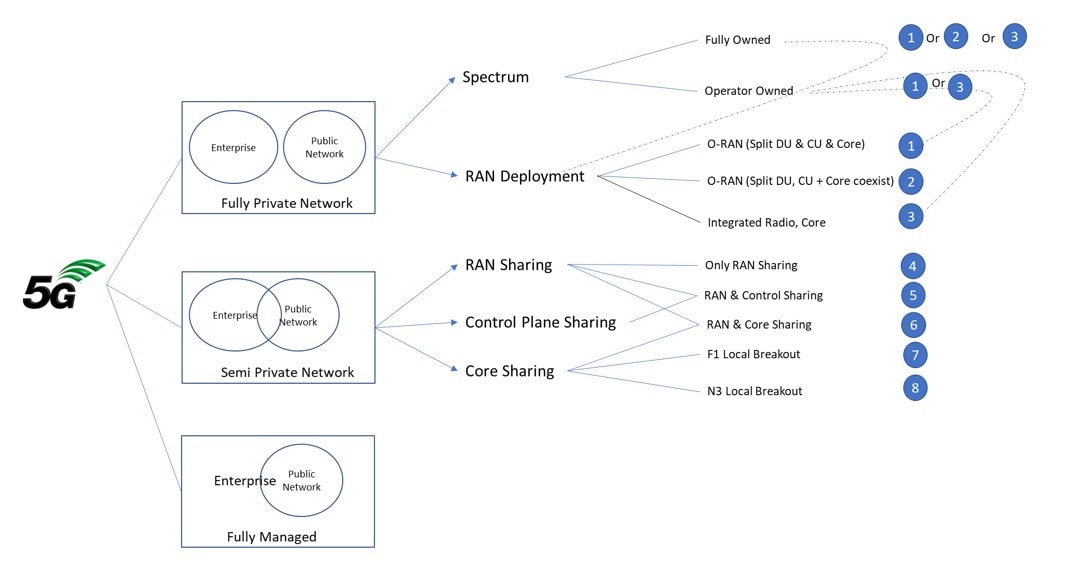
Source: Infosys
Private 5G network deployment scenarios depend on business needs, use case scale, geographical distribution, and type. The above depiction offers a simplified framework of these options and the following are some of the scenarios:
- Isolated 5G LAN built with a split of DU, CU, and Core (O-RAN)
- Isolated 5G LAN built with a split of DU, CU, having Core collocated with CU (O-RAN)
- Isolated 5G LAN build with Integrated Radio (RU+DU+CU) and Core separately deployed
- RAN sharing between a private and a public network
- RAN and Control Plane sharing between a private and a public network
- RAN and Core Sharing (end-to-end network slicing) between public and private networks
- N3 LBO (Local Breakout)
- F1 LBO (Local Breakout)
Figure 4: Fully private network
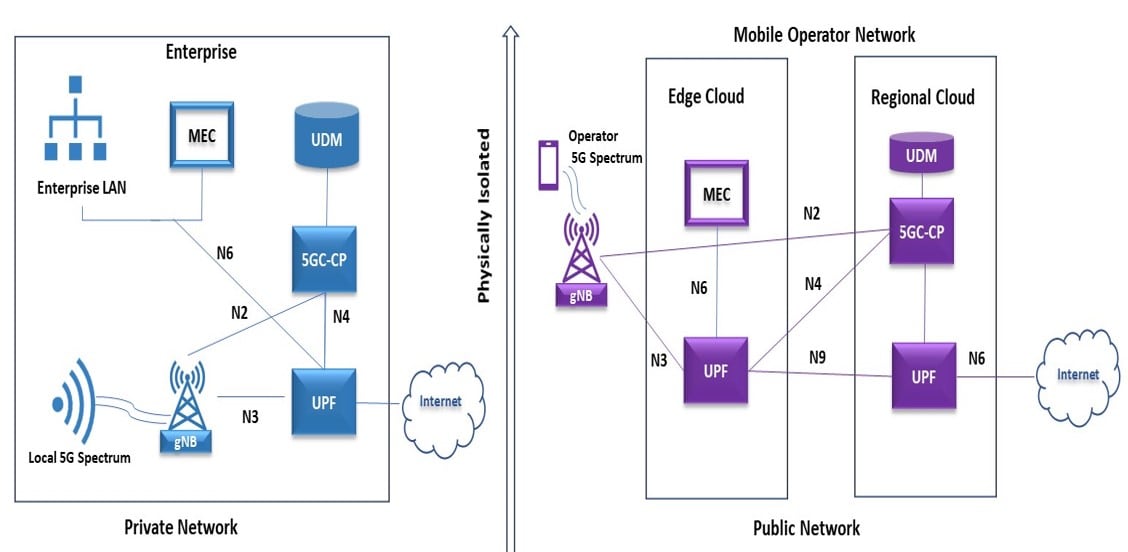
Source: Infosys
Isolated 5G LAN are typically built by enterprises where the enterprise will own and have licensed Local 5G frequency, which is full private and not on a sharing basis. In this scenario, the enterprise deploys the complete 5G network (gNB, UDM, 5GC, UPF, CP, MEC) within its premises (site/building).
RAN deployment options
According to the O-RAN Architecture, gNodeB can be split into two parts i.e., DU and CU.
- Centralized unit: A CU resides within gNode as a logical component and handles multiple functions like transfer of user data, mobility control, radio access network sharing, positioning, and session management. CUs operate DUs via the front haul (Fs) interface. CUs are also known as BBU, REC, RCC, C-RAN, and V-RAN. The CU is responsible for non-real time, higher L2 and L3 (network layer) functions.
- Distributed unit: DU, also known as RRH/RRU/RE/RU, interacts with real time layer 1 (L1, physical layer) and lower layer 2 (L2). L2 contains the data link layer and scheduling function. In this case, DU performs real-time L2 functions, baseband processing, and sits between CU and RU. It is proposed that the DU will support multiple layers of RUs. FPGA can be used to properly handle the digital signal processing and network traffic acceleration. Hardware acceleration is needed for DU to handle 5G traffic.
Figure 5: O-RAN – Split architecture for private 5G network
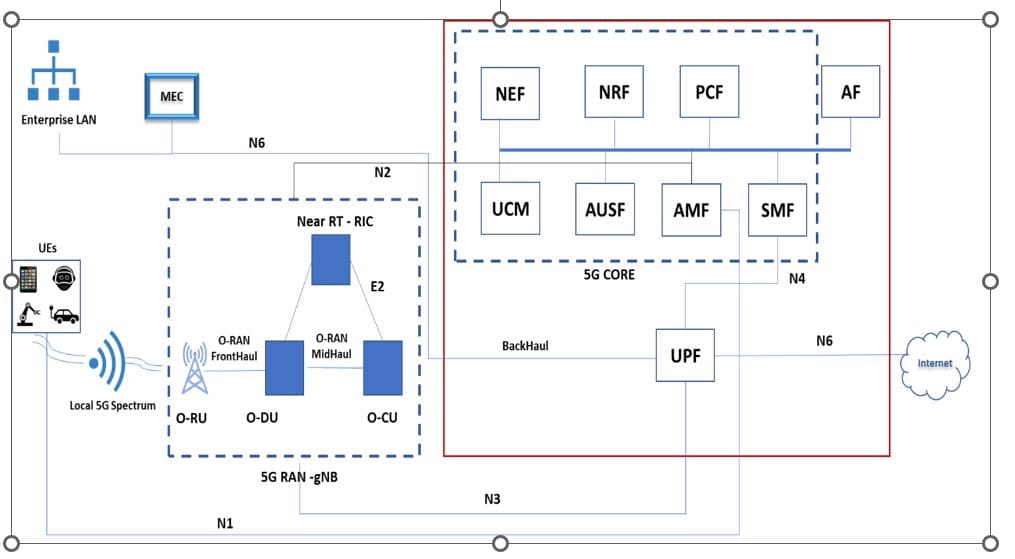
Source: Infosys
- O-RAN facilitates the following three options for gNodeB split:
- Split DU, CU, and Core and keep them separate.
- Isolate DU and deploy CU along with Core.
- Deploy integrated radio, i.e., DU+CU in one box.
The placement of CU, DU, and RU depends on factors such as latency requirement, throughout, density and user load, and availability of transport network.
Option 1: Isolated 5G network, with DU, CU, and Core separately deployed
Figure 6 – Isolated 5G network (DU, CU and Core separately deployed)
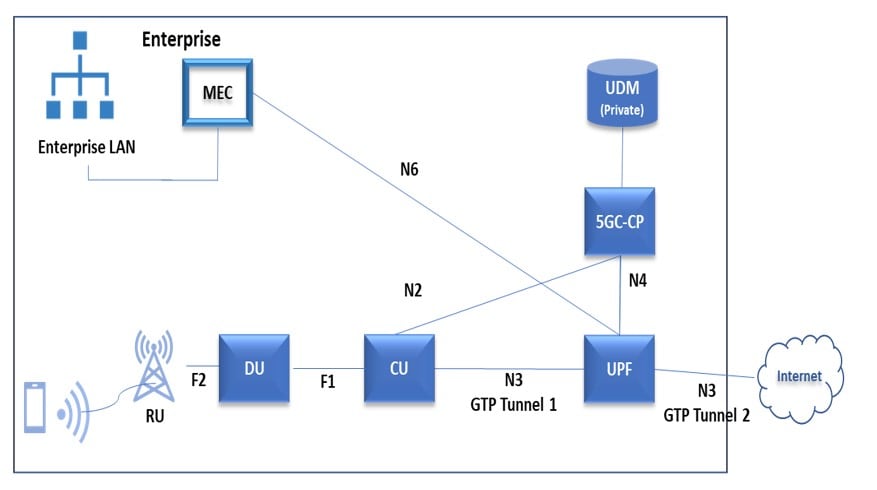
Source – Infosys
This is a pure O-RAN based deployment, where DU, CU, and Core are properly separated and deployed on distinct virtual infrastructure.
Figure 7 – gNodeB Split
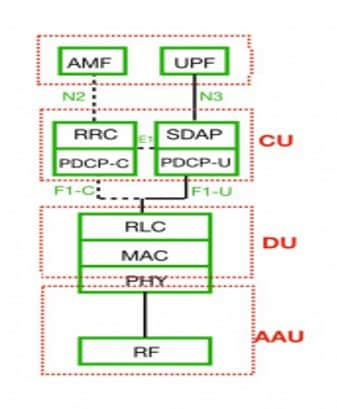
Consider the following factors during architecture splitting:
- QoS to be offered (latency, throughput, etc.)
- User density and load demand
- Application type i.e., real time/non-real time
- Radio network features such as enhanced inter-cell interference coordination, carrier Aggregation and coordinated multipoint.
Advantages of splitting NR/gNodeB into CU/DU
The following are some advantages of an architecture that allows for the separation and movement of new radio (NR) operations between CU and DU during deployment:
- Scalable, affordable solutions are made possible by flexible HW implementations.
- A split architecture (between CU and DU) provides NFV/SDN, real-time performance optimization, coordination for performance features and load management.
- Enables to adopt split architecture based on the use case.
Option 2: Isolated 5G network with DU, CU separation and CU deployed along with core
Figure 8 – Isolated 5G network (DU, CU separation and CU with core)
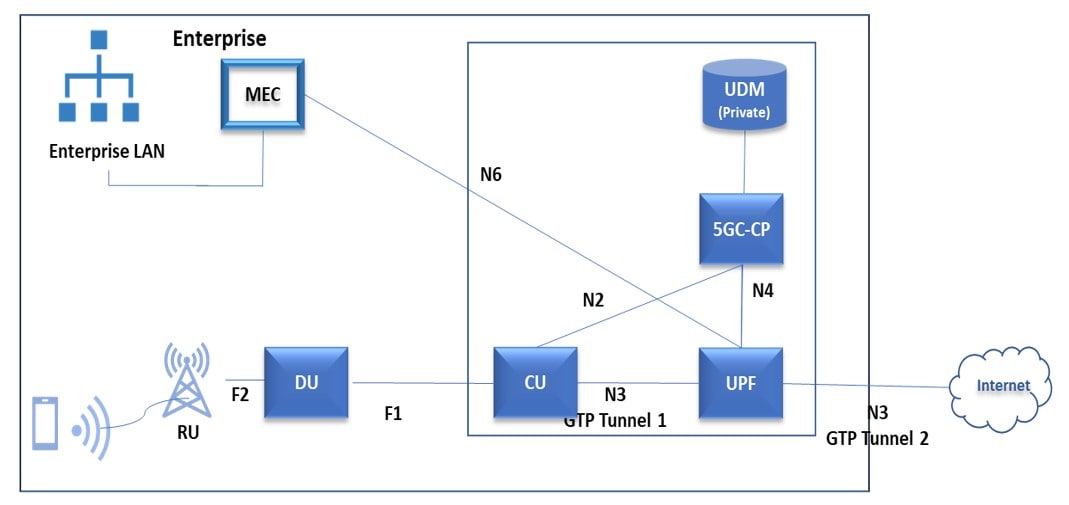
Source - Infosys
Deploy the CU in a centralized site with a mid-haul connection, along with core network. With sufficient bandwidth between CU and DU, this deployment works fine. It reduces server footprint, costs, and power consumption.
Option 3: Isolated 5G network with integrated radio and core deployed in separation
Figure 9 – Isolated 5G network (integrated radio and core in separation)
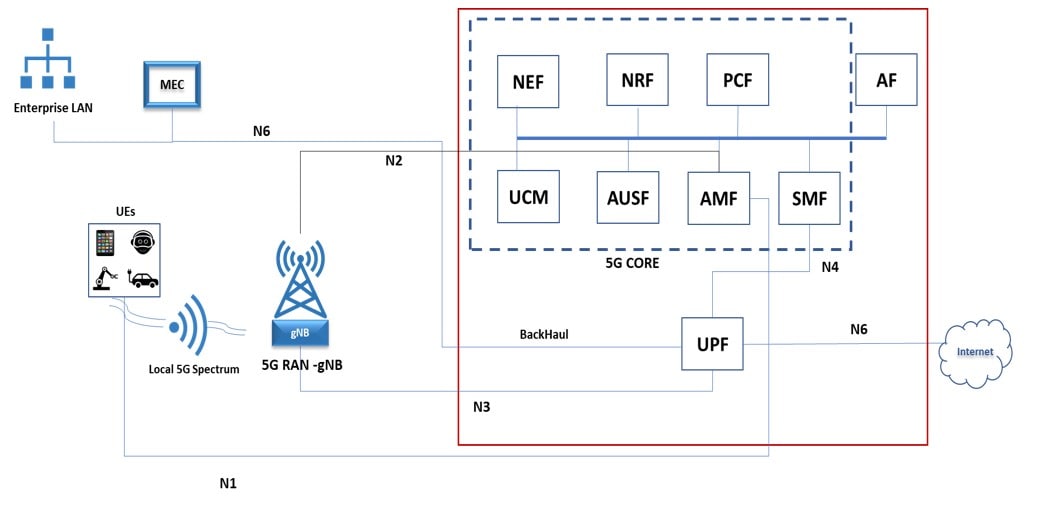
Source - Infosys
In this option, all components (RU+DU+CU) are integrated into a single box, reducing server footprint and cost. QoS is the primary reason to choose this option. This will negate all the scalability advantages that a split would offer.
Here are some points to consider when adopting this option:
- Where to deploy near real-time RIC? Is round trip time from RU/DU below 10ms?
- Distance between integrated radio and core should be less than 200km.
Spectrum on sharing basis
A private 5G LAN built by a mobile operator has similar architecture as that of a private 5G network built by an enterprise- owned spectrum. Spectrum is one of the broad criteria and options available for the enterprise are enterprise-owned spectrum and spectrum on a sharing mode.
In enterprise-owned spectrum
In this case, 5G frequency is owned by the enterprise and is local 5G frequency, and it is not licensed frequency of the mobile operators.
Offers full security within the enterprise network.
- Less likely to have integration-related challenges.
- Network can be tuned to the enterprise use case requirements.
- It would require more CAPEX, overall cost of ownership is an issue.
- It would have to deal with government processes/regulations to procure own spectrum. Sometimes this can be tricky for an enterprise to procure the available spectrum.
Spectrum on Sharing Basis
Figure 10 – Spectrum sharing basis
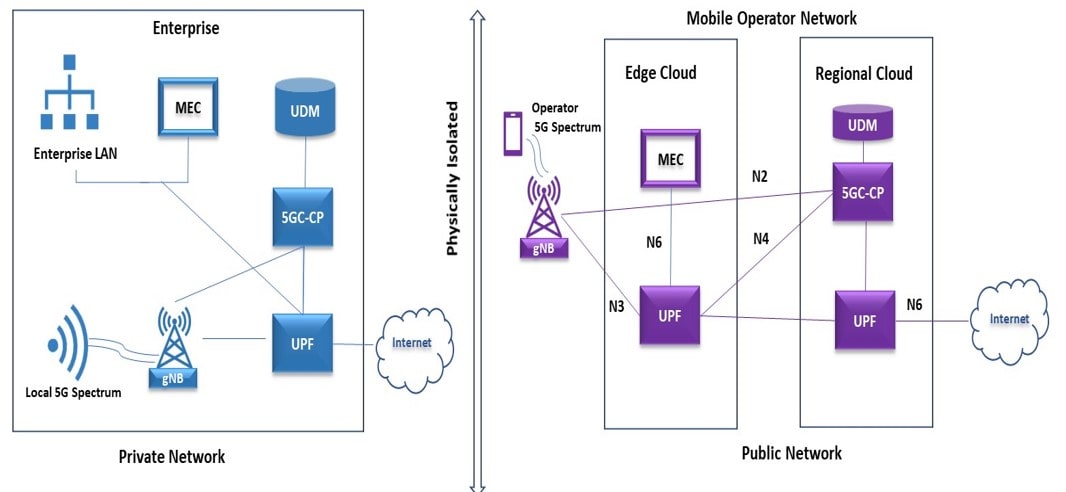
Source - Infosys
In spectrum sharing, the enterprise builds its 5G LAN using a licensed 5G frequency owned by the mobile operator. The use cases, pros, and cons are similar to a 5G network built by an enterprise with its own spectrum. Typically, mobile operators themselves deploy RAN. In this set up, spectrum procurement is delegated to the operator, freeing the enterprise from the concerns of government regulations. In exchange, the enterprise might need to pay the operator. Spectrum sharing offers full security within the enterprise network and is less likely to have integration-related challenges. However, some countries are not yet open to such spectrum-sharing arrangements.
Use Cases of private 5G networks
A private 5G network caters to the use cases shown in Figure xxxx. It provides a dedicated and secured private network for seamless operation and delivery of services. It offers more control, customized security, flexibility, low latency, network slicing, improved QoS, etc.
Figure 11. Use cases of private 5G networks
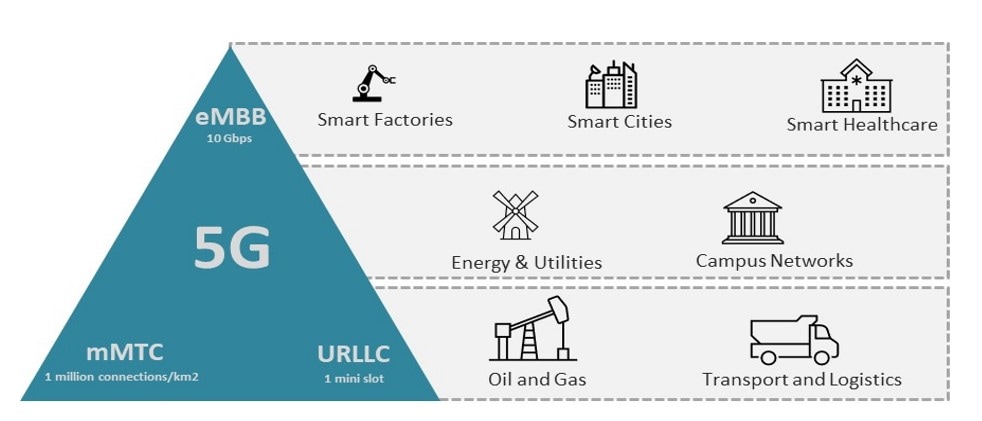
Source: Infosys
References of 5G private network deployments
Infosys private 5G deployment for a leading automotive major in Europe
Infosys, in collaboration with multiple network OEMs, deployed a private 5G network for a leading European automotive major. It continues to operate private 5G network as a service to enable innovative and automated use cases for automotive factory floor setup. The use cases include:
- Automated guided vehicles (AGV)
- Automated quality control
- Connected tooling
- Asset tracking
In the case of automated quality control, automobiles can be tested on the production line itself, removing post production testing. AGVs are deployed with seamless connectivity, and connected screwdrivers are utilized across the production line. The key to successful implementation has been in realizing ultrareliable low latency communications, enabling new use cases in automation, AI, and predictive maintenance leading to improved flexibility, efficiency, and quality of production lines in real time.
Private 5G deployment options: Pros and cons
Table 2 – Deployment options (Pros and Cons)
| Deployment type | Pros | Cons |
|---|---|---|
| Standalone private network using local frequencies |
|
|
| Standalone private network using operators licensed frequencies |
|
|
| Standalone private network with full O-Ran split |
|
|
| Standalone private network with DU, CU split. CU co-located with Core |
|
|
| Standalone private network with Integrated Radio and Core deployment separately |
|
|
| RAN sharing |
|
|
| RAN and control plane sharing |
|
|
| RAN and CORE Sharing |
|
|
| N3 LBO |
|
|
| F1 LBO |
|
|
Challenges of adopting a private 5G network
Private 5G deployments face challenges based on use case. Some common ones include:
- Device readiness: Device readiness is a challenge due to the lack of readily available devices, customization requirements, and gap between vendor offerings and customer needs. Also supporting of older version of existing devices in new network is a challenge.
- Spectrum access: The type of spectrum access depends on the deployment type and the use case being supported. Spectrum sharing may not be equal, so power output and the RF environment are important factors to consider, especially for large-area coverage.
- Enterprise skill sets: There is a skills gap for the deployment of private 5G networks. The complex ecosystem requires additional skills and people to build a private 5G network for a seamless transition and customer experience.
- E2E stack integration: End-to-end service orchestration of legacy architecture and complex networks is hard due to complicated ecosystem of vendors, devices, software, and hardware. E2E integration poses a major challenge, especially when every use case requires different customization.
- Network life cycle management: Frequent multi-upgrades in a private 5G network with multiple vendors pose interoperability challenges. Careful planning and management are necessary to address these issues, particularly when simultaneously dealing with legacy and new systems.
- Unified manageability across edges: Multiple edge sites across geographical regions must interoperate to ensure seamless user connectivity. This requires a common management layer, i.e., unified orchestration and life cycle management, across multiple regions and clusters.
- Edge infrastructure and locations: Locating, choosing, and managing the right infrastructure for edge access pose challenges in implementing a private 5G network.
- Cost of implementation: Private 5G implementation is costly due to expenses related to deployment, operations, maintenance, hardware, software, talent hiring, etc. While in a non-private network, many of these costs get distributed with other vendors.
Private 5G networks is the way forward
5G is revolutionizing our daily lives. With its presence in every industry and the need for superior and secured services, private 5G networks are the way forward for enterprises to invest and scale their networks to support evolving customer services. Enterprises need to plan their deployment type based on their requirements and regulations. Deployment options depend on factors such as latency, capacity, bandwidth, spectrum access, and specifically business needs.
As technology expands and exposes to endless possibilities, private 5G networks will drive the future of 5G implementation worldwide.
References
- 5G Deployment Options (devopedia.org)
- Seven Deployment Scenarios of Private 5G Networks
- 5G Spectrum: What It Is & Why It Matters (celona.io)
- GSMA | 5G Spectrum Guide - Everything You Need to Know - Spectrum
- Amantya (amantyatech.com)
- 5G Private Networks: Use Cases for Industry 4.0 - Instituto Eldorado
- GSMA | Mercedes-Benz 5G Factory | Internet of Things
- Four private 5G challenges, one big opportunity (rcrwireless.com)
- Volkswagen begins 5G private wireless network pilot project | Computer Weekly
- insights | Private 5G Fundamentals (twimbit.com)
- https://www.grandmetric.com/5g-core-network-functions/
- https://ntiprit.gov.in/pdf/imt20205g/5G_Core_Introduction.pdf
- https://www.rfglobalnet.com/doc/g-core-network-architecture-network-functions-and-interworking-0001
- https://www.5gfundamental.com/2020/06/5g-network-architecture.html
- https://www.techtarget.com/searchnetworking/definition/private-5G
- The Ultimate Guide to Open RAN: Deep Dive Into RU, DU, CU (thefastmode.com)

Subscribe
To keep yourself updated on the latest technology and industry trends subscribe to the Infosys Knowledge Institute's publications
Count me in!








